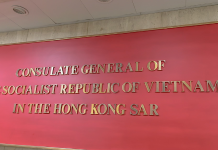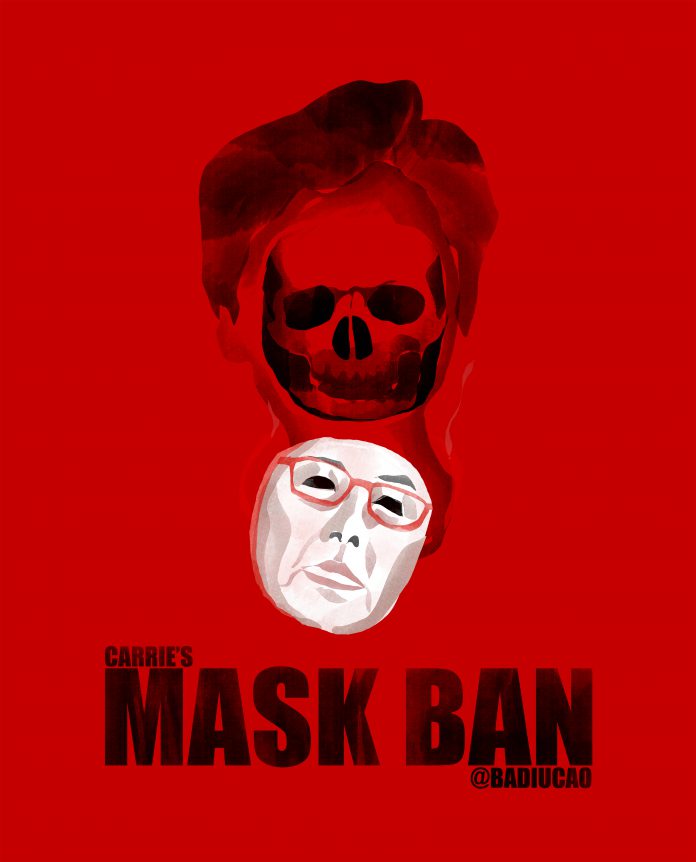Chinese-Aussie political artist Badiucao stands by Hongkongers with his cartoons.
By Mandy Yim
Badiucao, a Chinese-Aussie political cartoonist, describes himself as an “artist hated by the Chinese Government”. The 34-year-old artist lives by his nickname and stays anonymous for the sake of protecting his parents who now live in Mainland China.
Born and educated in Shanghai, he holds a law degree from the East China University of Political Science and Law. He gave up his Chinese citizenship and moved to Australia in 2009.
Start an Artistic Life
When studying at the university, he watched a video about the Tiananmen massacre in 1989 in his dormitory with his friends. He was shocked to learn how the Chinese authorities censored information about the student movement.
The clip, coupled with the tragic story of his grandfather, sowed the seed for his artist life.
As a filmmaker, Badiucao’s grandfather was targeted by the Chinese Communist Party during the “Hundred Flowers Campaign” in the 1950s. He was sent to a rural concentration camp and died later in the camp. “I realise that being an artist is extremely dangerous in China, so I left the country and restarted my life in Australia,” he says.
“Art can be dangerous for artists.”
Magnet of Danger
The artist started drawing political cartoons and posting them publicly on his Twitter account two years after moving to Australia. “Art can be dangerous for artists, especially when what the artist says or creates becomes a problem for the government,” Badiucao says.
Badiucao planned to hold his first international solo exhibition《#Gongle #共歌》in Hong Kong in October 2018. Yet, the event was called off because the Chinese authorities urged him to do so by threatening his family in Shanghai. He realised that his identity was known to the authorities.
“After the authorities learnt about my identity, I have become a potential threat to anyone I know in China. They might be in trouble just because of their connections with me. So, I cut connections with my parents and my friends,” Badiucao says.
Proudest Moment
The pursuit of freedom of speech and the sense of responsibility to educate the public are the two major driving forces that keep him creating arts despite all the troubles he is facing.
“As an artist, I have great respect from society. People look up to my artwork. My art serves the public,” he says.
His interest in political issues in Hong Kong started to grow when the city underwent the Anti-Extradition Law Amendment Bill (Anti-ELAB) Movement in 2019. The national security law, which came into effect on June 30, 2020, also captures his attention.

His friend once sent him photos, telling him that his drawings were held by Hong Kong protesters during a rally in June.
“I feel like, wow, that’s a great honour,” he smiles. “The cancellation of my exhibition in Hong Kong in 2018 was a huge setback. But I felt fully recovered when I saw my artwork was held by Hong Kong protesters. I felt really proud,” he says.
He designed the Lennon Wall Flag in September 2019 and posted it on his personal website, hoping that it could be a new symbol for Hong Kong’s freedom and resistance.
“Protests in Hong Kong since June have become the biggest inspiration of my art creation,” he stated on his website.
The Lennon Wall Flag consists of 96 coloured squares which symbolise colourful post-it notes on Lennon Walls in Hong Kong. The number – 96 – refers to the year before the handover in 1997. Every colour on the flag represents a different voice from Hong Kong.
On September 17, 2020, Badiucao received the 2020 Václav Havel International Prize for Creative Dissent from Human Rights Foundation for his design which has become a protest symbol of the Anti-ELAB Movement in Hong Kong and the global community.
“This award belongs to all the protesters of #HK #Uyghur #Tibet #Mongolia & #China. You are my inspiration and reason to make art!” he tweeted the day after receiving the prize.

Unbounded Art
Badiucao believes artwork will become more powerful after the introduction of the national security law because people can express their opinion in different art forms. He thinks there is always room for political artists to manoeuvre.
“The government can hardly control art because art has the power to define things.”
“Even if it (a word or a symbol) is banned, we can create new art,” he says citing a girl holding blank placards in a protest in Causeway Bay to show her defiance against the national security law on July 1, 2020, as an example.
He thinks the blank placard is already a form of expression in arts. “It is ridiculous and absurd for the government and the police to forbid holding blank placards in protests,” he says.

Badiucao says some Chinese artists are inspired by how Hongkongers share political posters and cartoons via Telegram groups.
Chinese political artists create a similar Telegram group which is called “Voice of CN” (In Chinese: 文宣中国). Group members are all Chinese.
“As they are afraid of the Chinese government, they make memes and pictures anonymously. I also share my artwork there,” he says.
“The government can hardly control art because art has the power to define things,” Badiucao says.
Edited by Lasley Lui & Regina Chen







































